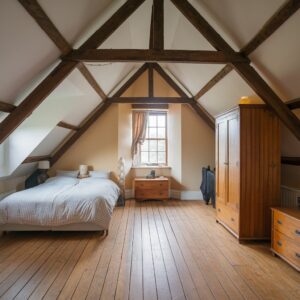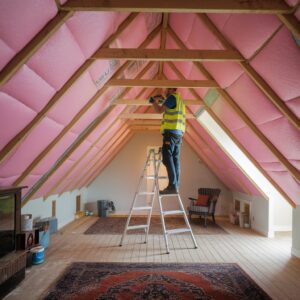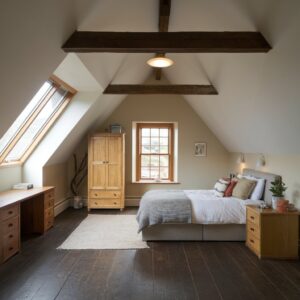Choosing between timber frame and brick for new homes involves weighing several factors. Timber frames offer design flexibility, quicker assembly, and superior insulation, aligning with eco-friendly preferences. Brick, however, provides unmatched durability and requires less maintenance. Timber frames are prone to pests and moisture, but excel in energy efficiency and sustainability. Brick’s robust foundation ensures longevity but has higher production emissions. The best choice depends on personal priorities; understanding these elements will offer valuable insights.
Key Takeaways
- Timber frames facilitate faster construction and design flexibility, while brick offers durability and classic appeal.
- Timber provides excellent insulation and energy efficiency; brick requires additional materials to achieve similar insulation levels.
- Timber is more sustainable due to its renewable nature, whereas brick production has a higher environmental impact.
- Timber frames need more maintenance for pests and moisture; brick homes require less frequent upkeep.
- Brick homes usually have lower initial costs, but timber homes benefit from off-site construction precision, reducing snag issues.
Timber Frame vs Brick: A Comprehensive Comparison for Your New Build
In evaluating the key differences between timber frame and brick construction for new builds, considerations around structural characteristics, insulation effectiveness, and environmental impact come to the forefront. Local building experts can provide tailored guidance based on site conditions, budget, and long-term goals.
Timber frames often offer superior insulation properties compared to brick, which can influence energy efficiency.
Additionally, the eco-friendliness of each option varies, with timber generally being more sustainable due to its renewable nature, while brick’s production process tends to have a higher carbon footprint.
What Are the Key Differences Between Timber Frame and Brick Buildings?
Understanding the key differences between timber frame and brick is crucial when considering construction materials for new homes.
Timber frame construction offers significant advantages in terms of speed of construction and design flexibility. Its lightweight nature allows for quicker assembly, which can appeal to those eager to join a new community. Additionally, timber frames provide structural versatility, accommodating diverse architectural designs and personal preferences.
In contrast, brick construction is renowned for its durability and classic appeal. Bricks offer a robust option among various home foundation types, often associated with a sense of permanence and tradition. Though typically slower to build, brick homes can evoke a sense of belonging through their timeless aesthetic. By pairing these qualities with modern British house design ideas, homeowners can achieve a blend of functionality, efficiency, and style.
Both options present unique insulation qualities, impacting energy efficiency and living comfort.
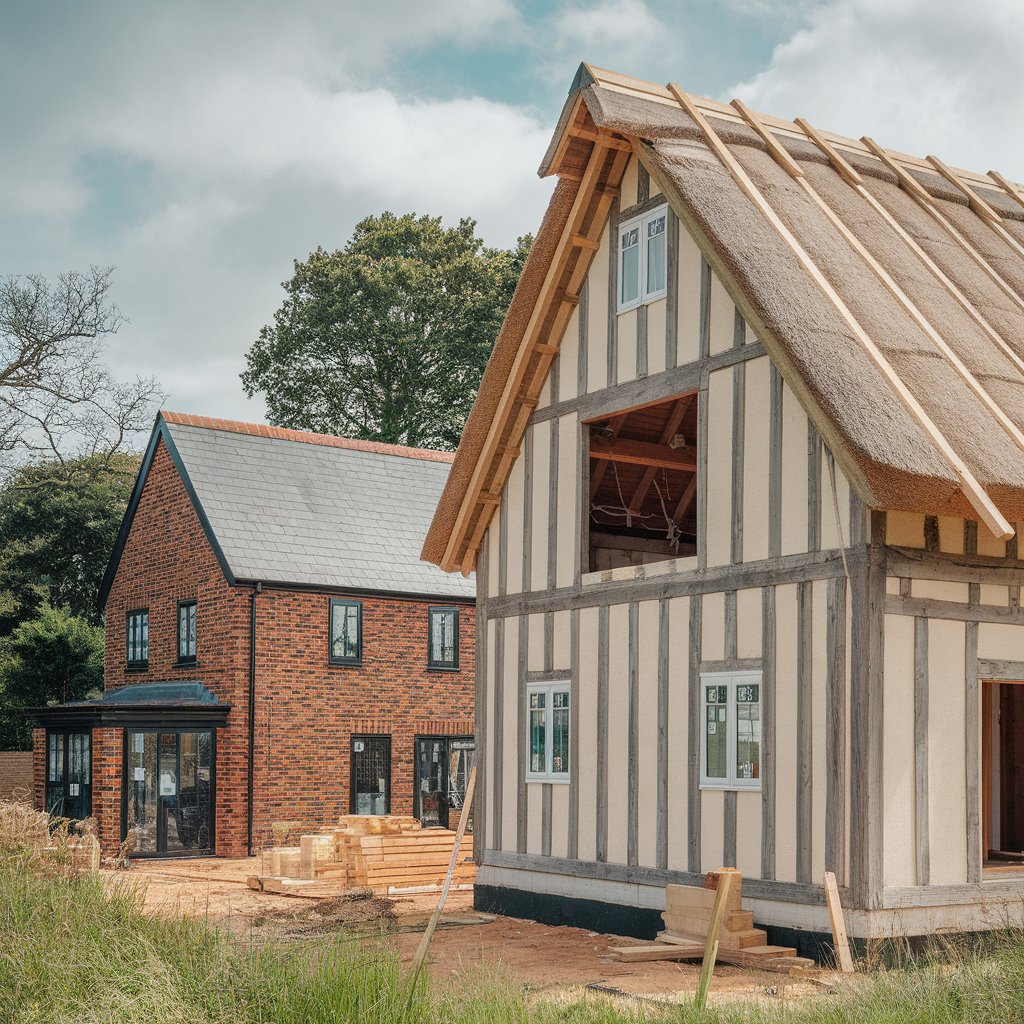
How Does Timber Frame Insulation Compare to Brick in New Builds?
Beyond structural considerations, the choice of building materials significantly influences a home’s thermal performance.
In new builds, timber frame construction and brick walls offer distinct approaches to insulation and energy efficiency. Timber frame construction typically allows for superior thermal insulation due to the ability to incorporate substantial insulating materials within the wall cavities. This can enhance energy efficiency, ensuring a cosy home environment while cutting energy costs for heating and cooling.
Conversely, brick walls, known for their durability, provide natural thermal mass, which can help regulate indoor temperatures by absorbing and releasing heat. However, achieving comparable insulation levels with brick may require additional layers or materials.
Both options present unique benefits;; ultimately, the homeowner’s specific needs and preferences determine the choice.
Which Is More Eco-Friendly: Timber Frame or Brick for Home Construction?
How does one determine the eco-friendly choice between timber frame and brick for home construction? Evaluating the environmental impact involves several considerations.
- Renewability: Timber is a renewable resource, sourced from forests that can be replanted.
- Carbon Footprint: Timber absorbs carbon dioxide during its growth, potentially offsetting its carbon footprint.
- Sustainable Material: Brick production involves high energy consumption, making it less sustainable.
- Longevity: Brick offers durability, reducing the need for frequent replacements and resource use.
- Recyclability: Both materials can be reused, but timber decomposes naturally, minimising waste.
Timber frames may present a more eco-friendly choice for those seeking to belong to a community conscious of environmental impact.
Each material has merits, but timber’s renewable nature and lower carbon footprint often sway preference.
How Does Durability Differ Between Timber Frame and Brick Buildings?
Examining the longevity of construction materials is a fundamental aspect of the decision-making process for new builds. Timber frame buildings offer a flexible construction option, but concerns about their long-term durability often arise. While they can last for decades with proper maintenance, their vulnerability to pests and moisture can affect longevity. In contrast, masonry walls are celebrated for their robust strength and durability, often standing firm for generations.
| Aspect | Timber Frame Buildings | Masonry Walls |
|---|---|---|
| Durability | Vulnerable to pests, requires maintenance | High strength, minimal maintenance |
| Longevity | Can last for decades with care | Typically lasts for generations |
| Strength | Flexible strength, less weight | Solid strength and durability |
| Maintenance | Regular inspections and treatment needed | Low maintenance needs |
Choosing between these materials depends on balancing immediate needs with future aspirations for belonging and stability.
Which Building Material Offers Better Thermal Insulation: Timber or Brick?
Although timber frame and brick constructions have unique advantages, their thermal insulation properties significantly differ.
Timber frames generally insulate better due to their ability to trap air within the structure, offering a cosy environment. In contrast, bricks excel in thermal mass, absorbing and releasing heat slowly, which is beneficial in fluctuating weather conditions.
Here are some points to consider in the timber frame vs brick debate:
- Timber frames allow quicker construction time and are ideal for tight schedules.
- Bricks offer high thermal mass, maintaining stable indoor temperatures.
- Timber tends to insulate more effectively, reducing energy usage.
- Bricks are often preferred in areas with extreme weather due to their durability.
- Timber frames provide flexibility in design, appealing to modern tastes.
Choosing the right building material hinges on specific needs and priorities.
Energy Efficiency: Timber Frame vs Brick for Your New Home
When evaluating energy efficiency for new homes, the choice between timber frame and brick construction plays a crucial role.
Timber frames are often praised for their superior insulation capabilities, potentially leading to reduced energy costs over time.
Conversely, brick homes are known for their thermal mass, which can help regulate indoor temperatures, influencing overall energy performance.
Timber Frame vs Brick: Which is Best for a New Home’s Energy Efficiency?
How does one determine whether a timber frame or brick is more energy-efficient for a new home? As timber-framed buildings are growing in popularity, many seek clarity on energy efficiency.
Comparing traditional brick and timber as building materials involves various factors:
- Insulation Capabilities: Timber frames often offer superior insulation, reducing energy costs.
- Construction Process: Timber’s lighter weight can lead to quicker builds, impacting energy use during construction.
- Thermal Mass: Traditional brick provides thermal mass, stabilising indoor temperatures.
- Sustainability: Timber is renewable, aligning with eco-friendly design preferences.
- Adaptability: Timber allows for flexible designs to maximise energy efficiency.
How Does Timber Frame Insulation Impact Energy Costs in New Builds?
Timber frame insulation significantly influences energy costs in new builds by providing enhanced thermal efficiency. The inherent properties of timber-framed structures allow for superior insulation, creating a comfortable environment while minimising energy expenses. Timber construction is often less expensive than traditional brick builds, making it an attractive option for new homeowners.
Using renewable timber aligns with sustainable living aspirations and meets NHBC standards in the UK, fostering a connection among eco-conscious homeowners. This type of build ensures strong insulation and contributes to reducing labour costs due to its speedier assembly compared to traditional brick builds.
As a result, new homeowners can enjoy reduced energy costs and a quicker move-in timeline. Opting for timber-framed homes supports an eco-friendly lifestyle, ensuring one’s living space is economically sensible and environmentally responsible, promoting a shared commitment to sustainability.
What Is the Thermal Performance of Brick vs Timber Frame Homes?
While timber frame construction offers excellent insulation and energy savings, evaluating the thermal performance of brick versus timber frame homes is essential to understanding overall energy efficiency.
In new build homes, the choice between these materials can impact comfort and environmental footprint.
Timber frames are known for:
- Superior insulation reduces heating and cooling needs.
- Lower CO2 emissions during construction compared to brick.
- Faster construction times, streamlining the building process.
- Adaptability to incorporate advanced insulation materials.
- Reduced thermal bridging, minimising heat loss.
Conversely, brick provides:
- High thermal mass stabilises internal temperatures.
- Durability and low maintenance over time.
Choosing between timber frame and brick involves balancing initial construction impacts with long-term energy efficiency and environmental benefits.

Durability and Maintenance: Timber Frame vs Brick for New Builds
When considering the durability of new homes, timber frames and bricks present distinct advantages and challenges. The choice often depends on the construction method and whether the design requires planning permission.
Timber frames, including wooden frame homes, are typically praised for their flexibility and resistance to specific environmental stresses. However, they may require frequent maintenance to prevent rot or insect damage, especially around critical beams.
Conversely, brick and concrete blocks are often lauded for their robustness and longevity, though they, too, demand upkeep to address potential problems like mortar deterioration. Considering these factors can guide homeowners in choosing their new build.
Timber Frame vs Brick: Which Offers Better Durability for a New Build?
Although both timber frame and brick homes have unique advantages, the question of which material offers better durability for new builds remains a topic of discussion.
The debate of timber vs brick hinges on several key considerations:
- Timber offers durability through modern treatments, yet remains susceptible to rot if not maintained.
- Brick is long-lasting, often enduring for centuries with minimal maintenance.
- Construction method plays a significant role; timber allows for faster builds, while brick provides a solid, robust finish.
- Low maintenance is a hallmark of brick, reducing long-term upkeep demands.
- Environmental factors influence durability; timber may be more vulnerable to pests and moisture than brick’s steadfast nature.
Understanding these factors helps individuals feel connected to their choice of home construction.
How Does Timber Frame Hold Up Against the Durability of Brick in Construction?
Despite the ongoing debate, the comparison between timber frame and brick in terms of durability and maintenance reveals distinct characteristics.
Timber, known for its flexibility, offers resilience in construction, especially in areas susceptible to seismic activity. However, its organic nature can be a disadvantage, as it is more prone to damage from pests and moisture than brick.
With its long-standing reputation for robustness, Brick provides excellent durability, often becoming the preference for those seeking longevity. In the timber vs brick debate, brick’s resistance to fire and weathering contributes to its appeal in harsh climates.
While timber offers a sustainable option with modern treatments enhancing its lifespan, many still lean towards brick for its enduring strength and minimal maintenance needs.
What are the maintenance considerations for timber frames vs. brick homes?
Maintenance considerations for timber frame and brick homes differ significantly, impacting long-term upkeep and cost.
Timber frame homes require regular attention to prevent rot and pest infestations. Consistent inspection and maintenance are crucial to ensure longevity and safeguard the structure.
Conversely, brick homes generally demand less frequent care, though they are not without their own needs.
- Routine inspections are crucial for both types to identify early signs of wear.
- Timber frames need protection against moisture to prevent rot.
- Brick exteriors may require repointing to maintain structural integrity.
- Pest control is critical for timber to avoid damage from insects.
- Staining or sealing timber can enhance durability and aesthetics.
Understanding these maintenance considerations fosters a sense of belonging among homeowners, ensuring their homes remain safe and welcoming.
Timber Frame vs Brick: Key Considerations for Your New Home or Extension
When deciding between timber frame and brick for a new home or extension, several key factors come into play. Timber frame construction often involves prefabrication, allowing the build to be much quicker and ensuring the structure is watertight early in the process.
The potential for new build snagging, differences in the inspection process, and sustainability considerations all influence this choice. Using timber can also eliminate impact and airborne waste during construction, making it a cleaner option.
Each material presents distinct advantages and challenges crucial for prospective homeowners to evaluate.
How Does Timber Frame Compare to Brick in Terms of New Build Snagging?
Why is snagging a crucial consideration when choosing between timber frame and brick for new builds? Snagging identifies construction flaws that might be hidden beneath the surface.
Timber frame homes often benefit from off-site construction, where precision and quality control can minimise potential snags. In contrast, brick construction might present more on-site challenges and be potentially more expensive than timber.
Key considerations include:
- Timber frame: Offsite construction allows for better quality control.
- Brick: Susceptible to more on-site construction errors.
- New build snagging: Critical for uncovering hidden flaws in both methods.
- Cost: Brick may incur higher snagging costs than timber.
- Quality: Timber’s precision in off-site construction can reduce snag issues.
Belonging to a community that values quality craftsmanship enhances the new home experience.
How Does the Inspection Process Differ for Timber Frame vs Brick Homes?
What distinguishes the inspection process for timber frame homes from brick homes? The inspection process varies primarily due to the materials and construction techniques involved. Timber frame homes require detailed attention to the frame’s alignment, moisture content, and pest resistance, while brick homes focus more on the masonry’s structural integrity and brickwork specifications.
| Aspect | Timber Frame Inspection | Brick Home Inspection |
|---|---|---|
| Structural Integrity | Frame alignment checks | Masonry and brickwork analysis |
| Moisture Management | Check for timber moisture | Inspect mortar and drainage |
| Pest Resistance | Evaluate timber treatments | Less concern for pests |
Both inspection types demand adherence to rigorous standards, ensuring that the home meets safety and quality specifications. By understanding these differences, potential homeowners can feel assured of their choice, fostering a sense of belonging in their new community.
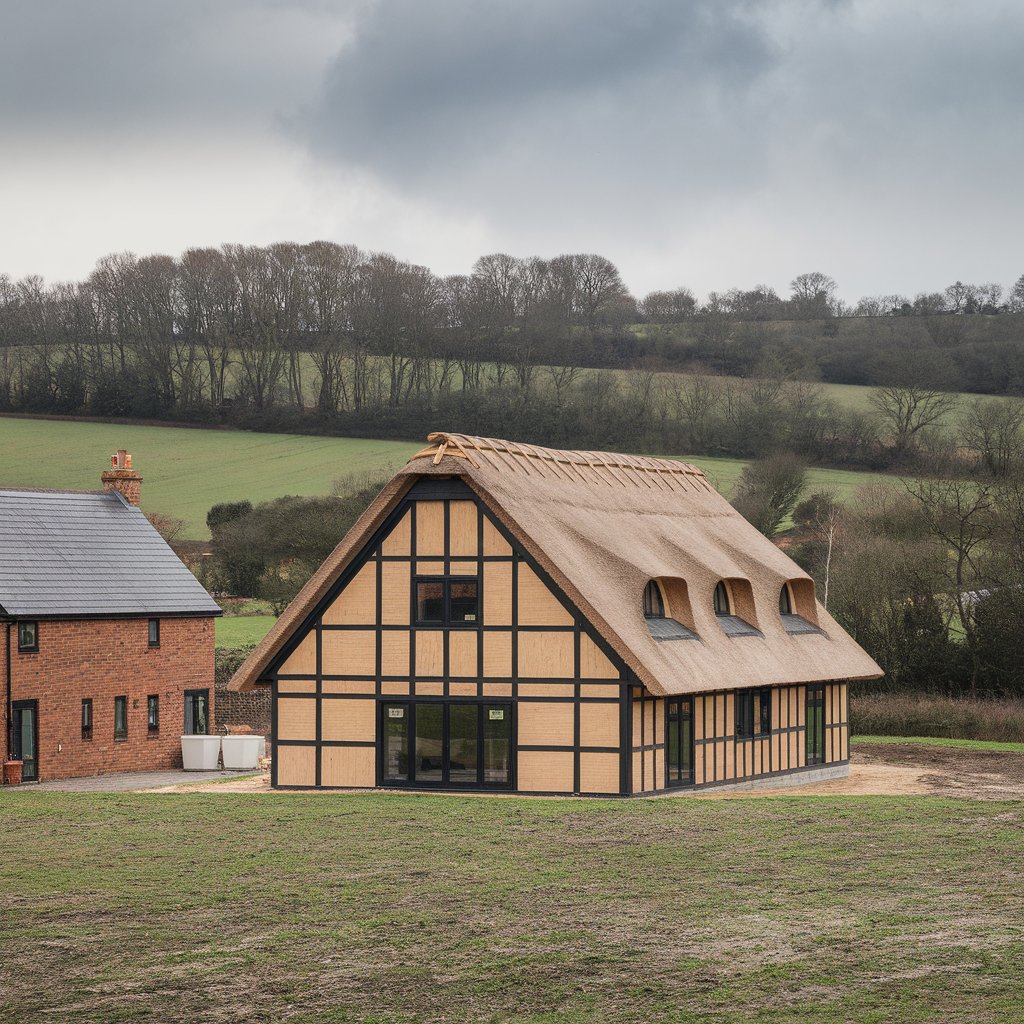
Which Is More Sustainable: Timber Frame or Brick for a New Home?
As environmental concerns grow, the sustainability of building materials like timber frames and brick becomes a critical factor in new home construction.
Due to its renewable nature, Timber often stands out as a sustainable option. Here are key considerations when evaluating the sustainability of timber versus brick:
- Timber is a renewable resource, capable of being replenished naturally over time.
- The nature of timber allows it to absorb CO2, helping reduce carbon footprints during construction.
- Timber from well-managed forests supports the responsible use of natural resources.
- Brick production involves energy-intensive processes, often resulting in higher emissions.
- Timber construction generally uses fewer raw materials, reducing waste and promoting eco-friendly building practices.
These factors highlight the potential of timber frames in fostering sustainable construction.
Conclusion
In conclusion, choosing between timber frame and brick for new build homes is one of the most significant decisions a homeowner can make. This ultimate guide can help you make an informed choice by weighing various factors. Timber frames offer speed in construction and superior energy efficiency, while brick provides durability and low maintenance. Each material has distinct advantages and potential drawbacks, influenced by climate, budget, and personal preferences. Ultimately, the decision hinges on prioritising these elements to meet the specific needs and vision for the home, ensuring a comfortable and sustainable living environment.


